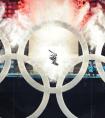West Vancouver, British Columbia (CNN) -- It's more than two hours before snowboard practice begins, two hours before Robert Beck will take his first picture, and he is trudging up the steep icy slope that is one lip of the halfpipe.
Temperatures are just above freezing on Cypress Mountain, and Beck, a Sports Illustrated photographer for 24 years, is steadily ambling up the hill to stake out his position near the top. The climb is just 160 meters, but try doing it with a 50- or 60-pound pack on your back and a bad knee repaired just three weeks ago.
It's going to be worth it; Beck knows precisely where he needs to be to get the perfect picture when the overwhelming gold medal favorite Shaun White performs.
For the next nine hours Beck won't leave his spot -- he's not allowed to come back down until the competition is over -- so he has a bag full of equipment and provisions. He carries three camera bodies, four lenses, several radios to remotely trigger cameras and a bunch of Cliff bars. (McDonald's might sponsor these Games, but there's no Golden Arches on the hill).
See 19 of Robert Beck's amazing SI photos from the Winter Games
He knows where to be to get the shot he wants because Beck and his assistant, Kohjiro "Kojo" Kinno have been photographing White for months, learning his every move and tendency.
For instance, Beck knows the best time to shoot a close-up of White is during his first practice run because the snowboarder doesn't go as high then.
They went to three World Cup events and the X Games, shooting White and his competitors in preparation for the Olympics. Then once in Vancouver it was off to every practice to test out different angles to shoot.
"We're trying to frame it just right," Beck said on the drive from his hotel to the venue. "On their tricks, snowboarders are spinning so fast. Sometimes you never see their faces. You don't want to get pictures of rear ends or the bottom of the board. We want to get their faces if we can."
Beck, who has more than 50 Sports Illustrated covers to his credit, is frustrated even before he climbs the hill. Kinno is an important part of the "we" he talks about. Kinno has been there for him for nearly seven years, handing him the right equipment, fixing things when they go wonky, running cards back to the work area and often being the voice of reason. But that won't happen today because officials wouldn't give Kinno a photographer's armband. He's not even allowed to shoot pictures from a lower area of the venue.
It's almost like a pitcher without his catcher, though the understated Kinno often is the one who shakes Beck off. And then there's the eye roll. They have this way of disagreeing that only longtime friends can have. There's often disagreement, Kinno says, but they always come to an understanding.
On this Wednesday at the halfpipe, Kinno will have to stay in front of a laptop all day, trying patiently to wait for runners to bring him the cards from the cameras. At least he has company. John Birk, photographer Al Tielemans' assistant, can't go with his photographer either. Tielemans will spot up on the other side of the pipe while photographer Bob Martin will be positioned at the bottom.
--Robert Beck, Sports Illustrated photographer
Just before setting off for the hill, Beck gets a call from Steve Fine, SI's director of photography. Fine has a request for Beck to get White at a certain angle. Beck's sure he can't and tells Fine that he has a great shot in mind, looking up the pipe as White soars into action. Fine likes that but wants to have one with the crowd in the background. Beck and Kinno agree; it's not a clean shot from where Beck will be, but they can try and see what Fine says.
You'd think that Beck can call the shots, so to speak, and send in his favorites from the 1,400 images he will take this day, but that's not the way it works. He lets the photo editors pick the ones they want.
"I don't suggest anything to those guys," Beck said. "I can't control it. I make the best pictures I can, send them, in and it's out of my hands.'
He seems cool with that. He's much more concerned with getting a shot that is different from other photogs. It's difficult -- well, almost impossible really -- to be inventive with this assignment, though. There are going to be several other photographers in the same area, and dozens all over the pipe. He'll try to nail it the best he can by using a different lens than others near him (maybe a 35 mm while lying down in the snow) and also through the use of a camera on a 12-foot stick he'll hold up. There's one big issue, though, with White.
Beck says when he has used a remote-fired camera, he's able to get other snowboarders in the frame perfectly, but White soars so high that much of the time he's at the top of the frame, if he's even in the picture.
Beck's assignment is not solely White; it's just that the 23-year-old budding legend is such a prohibitive favorite it makes sense to Beck that's his main target. He's shooting for the magazine, but he also hopes the Web site can use his photos. In fact, the Web is much more of a sure thing this time. Sports Illustrated's deadlines aren't until the weekend, and the magazine won't arrive at subscribers' homes until a week after the event, so Beck figures it's unlikely this gig has cover potential. And with Lindsey Vonn such a compelling story, too, he's not sure that he'll even get one image in the magazine.
Celebration photos always play well, but only the photographers at the bottom will have White right in front of them. Beck halfway wishes he could shoot those photos instead of Martin.
"We're all basically competitive," he says wistfully. "But you can't be both places."
SI.com: Photos of White's winning run
White did the expected and easily won gold. Back in the work area, Beck says not everything went well. Counting practice, each rider who made the final made nine runs. Beck says he solved a problem with one of the remote cameras in time to shoot the first practice session, but at some point he accidentally hit the focus.
"Everything looked like Mr. Magoo [took them]," he said.
At least 75 percent of photography is problem solving, he said. (Two-and-half percent of photography is skill, he joked). It's knowing where to set up, knowing your equipment and knowing how to fix that equipment when it breaks. But while you're fixing things, you're missing pictures, and it's frustrating.
And then there's just plain bad luck. Beck says that during one practice run a TV cameraman ran in front of him, snapping pictures on his phone. But these are the things you deal with, he says.
He's a little down at dinner afterward because he caught a glimpse of the some of the other photographers' pictures. As he had predicted, a bunch of shots with White, his face one big smile, holding the U.S. flag.
But later his mood changes when back at the hotel suite he logs onto the SI.com Web site. There is a picture, looking up the pipe of White, cast against a clear night sky, soaring through the air, on his way to a gold medal.
As for the magazine, he'll be waiting, just like the rest of us
文章来源于网络,如有侵权请联系我们,将会在第一时间处理
更多资讯可以关注微信公众号:IELTSIM。
[AD] 点击此处了解【雅思合集】【学习计划定制】【终生VIP服务】




